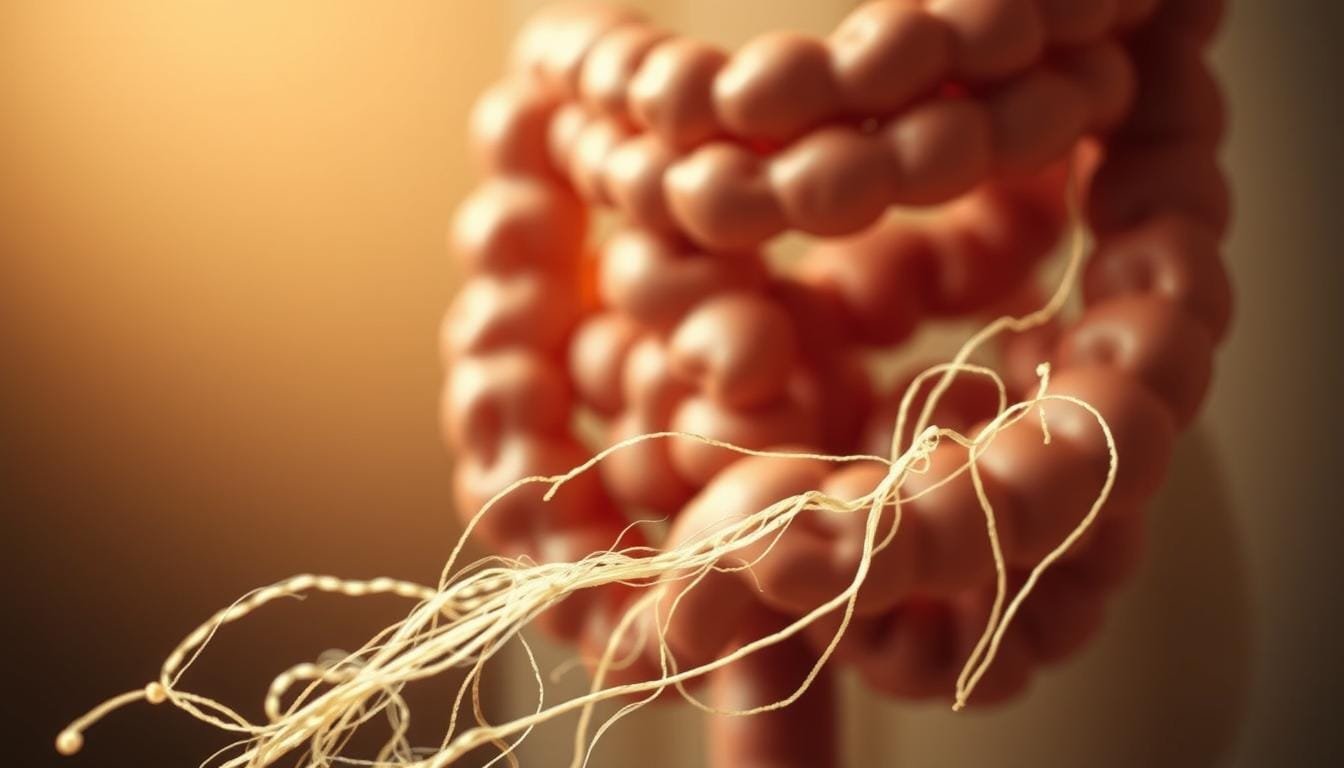Currently Empty: RM0.00
Fiber is essential for digestion, but can too much of it cause problems? Surprisingly, 95% of people worldwide don’t meet daily fiber recommendations, yet overconsumption can lead to discomfort. Many experience bloating, constipation, or even temporary weight gain when intake isn’t balanced.
In Malaysia, rice-heavy diets and common IBS triggers make fiber management crucial. Studies show 77% of chronic constipation cases improve with proper fiber adjustments. Wellness Concept, a trusted digestive health partner, emphasizes hydration and exercise to counter these effects.
Excess fiber absorbs water, sometimes leading to intestinal blockage if ignored. Recognizing symptoms early helps maintain digestive harmony. Let’s explore how to strike the right balance for optimal health.
Key Takeaways
- Over 90% of adults fall short of daily fiber targets.
- Excess intake may cause bloating or constipation.
- Rice-heavy diets require mindful fiber adjustments.
- Hydration and exercise ease digestion.
- Wellness Concept supports balanced digestive health.
Understanding Fiber and Its Role in Digestion
Your gut relies on two types of fiber—soluble and insoluble—to function smoothly. Soluble fiber, found in oats and pisang, dissolves into a gel-like substance that slows digestion. Insoluble fiber, abundant in whole grains, adds bulk to stool, acting like an “intestinal broom” to sweep waste through.
Think of them as traffic controllers: soluble fiber regulates nutrient absorption, while insoluble fiber keeps bowel movements regular. Fermentable fibers, like those in Malaysian oat porridge, feed beneficial gut bacteria, boosting immunity and reducing inflammation.
Local diets rich in spices benefit from fiber’s pH-balancing effects. For example:
- Soluble fiber in oats helps manage blood sugar—key for diabetes prevention.
- Insoluble fiber in brown rice combats diverticulitis, common in rice-heavy diets.
The USDA recommends 14g of dietary fiber per 1,000 calories. Overloading can block zinc/iron absorption, so balance is crucial. For IBS sufferers, pairing fiber with hydration—like sipping teh tarik—eases digestion.
In short, fiber is your gut’s gym equipment: strengthening digestion while preventing heart disease and diabetes. Adjust intake mindfully for optimal health.
What Happens to Stool with Too Much Fiber?
Balancing fiber intake is key—excess may disrupt gut health. While fiber keeps digestion smooth, overconsumption leads to noticeable changes. The body reacts differently to soluble and insoluble types, creating a range of symptoms.
Common Symptoms of Excessive Fiber Intake
Too much insoluble fiber, like that in brown rice, can cause paradoxical constipation. Instead of softening stool, it speeds transit, leaving behind hard, pebble-like pieces. A 2012 study found 63 patients improved by reducing their fiber intake.
Local diets heavy in legumes or cruciferous veggies may increase gas. Fermentation in the gut produces bloating, especially with sudden intake spikes. Temporary water retention can mimic weight gain, confusing those tracking wellness goals.
How Fiber Affects Stool Consistency
Soluble fiber, like oats, forms a gel that slows digestion. Insoluble fiber adds bulk, but excess turns stool from log-like to fragmented. Think of it as a sponge—without enough water, it becomes rigid.
For Malaysians managing diabetes, blood sugar drops may occur if fiber overwhelms digestion. Chronic overuse risks intestinal blockage, particularly with conditions like Crohn’s. An office worker’s case showed supplements caused acute bloating within hours.
Self-Check Checklist:
- Bloating after high-fiber meals?
- Hard, infrequent bowel movements?
- Gas from beans or broccoli?
- Sudden weight fluctuations?
Types of Fiber and Their Effects
Like monsoon and dry seasons, soluble and insoluble fibers play distinct roles in gut health. While both aid digestion, their impacts vary—especially in Malaysian diets rich in rice and spices. Understanding these differences helps prevent discomfort and optimize nutrient absorption.
Soluble Fiber: Benefits and Risks
Soluble fiber, found in oats, barley, and dragon fruit, dissolves into a gel that slows digestion. This helps stabilize blood sugar—a boon for diabetes prevention. Psyllium, a popular supplement, is proven to ease IBS symptoms by softening stool.
However, overdoing it can backfire. Fermentable fibers like chicory root (common in “healthy” snacks) may cause bloating. Urban dwellers with sedentary lifestyles often experience fermentation overload from processed foods with hidden fibers.
- Local sources: Oat porridge, barley drinks, passionfruit.
- Tip: Soak oats overnight to reduce fiber content for sensitive stomachs.
Insoluble Fiber: When Too Much Becomes a Problem
Insoluble fiber, abundant in brown rice and leafy greens, adds bulk to stool. But excessive intake—common in rural areas with veggie-heavy diets—can irritate the intestines. Wheat bran, for instance, may trigger painful gas if consumed unchecked.
High-FODMAP foods like garlic and onions worsen the issue by fermenting rapidly. A 2021 study linked overconsumption to hemorrhoid risks due to straining. Portion control is key—aim for palm-sized servings of whole grains per meal.
“Sudden spikes in insoluble fiber intake often lead to constipation, not relief.”
How to Manage Excessive Fiber Intake
Managing fiber overload requires smart dietary tweaks and lifestyle adjustments. When the gut feels sluggish or bloated, temporary changes can reset digestion without sacrificing long-term health benefits.

Reducing Fiber Temporarily
A short fiber diet break helps the gut recover. For 3 days, focus on low-fiber foods like white rice, peeled potatoes, and silken tofu—staples in Malaysian cuisine. Avoid common pitfalls like overcompensating with fatty foods, which slow digestion further.
“Sudden fiber cessation can shock the system. Gradually reintroduce high-fiber foods over 2 weeks to avoid rebound bloating.”
Sample 3-Day Plan:
| Day | Meal | Local Dish Example |
|---|---|---|
| 1 | Breakfast | White rice porridge with ginger |
| 1 | Lunch | Steamed fish with peeled potatoes |
| 1 | Dinner | Silken tofu soup with bok choy |
Increasing Fluid and Exercise
Water is fiber’s partner—without it, stool hardens. Aim for 2.5L daily in Malaysia’s humid climate. Drink a glass before meals to prep the gut. Herbal teas like lemongrass or ginger ease bloating naturally.
Light exercise boosts digestion by 30%. A brisk 20-minute walk at KLCC Park or cycling helps move fiber through the intestines. Pair movement with hydration for best results.
- Hydration hack: Infuse water with pandan leaves for flavor.
- Exercise tip: Post-meal stretching reduces gas buildup.
During Ramadan or Eid, adjust fiber intake slowly. Swap high-fiber dates for small portions of watermelon to stay hydrated.
Dietary Adjustments for Balanced Fiber Intake
Adjusting fiber intake requires knowing which foods to prioritize and which to limit. While fiber supports digestion, overdoing certain types can backfire. Smart swaps and mindful eating keep the gut happy.
Foods to Avoid When Overconsumed
Some fiber-rich foods like chia seeds and bran flakes pack a punch. They absorb water rapidly, risking bloating or constipation. Processed “health” snacks, such as fiber bars, often hide excess grams under a “health halo.”
Traditional dishes like nasi lemak can be modified—reduce sambal (high in onions) to lower insoluble fiber. Sauces and condiments also add hidden bulk. A 2021 study linked overuse of wheat bran to hemorrhoid flare-ups.
Best Low-Fiber Alternatives
For sensitive stomachs, peeled fruits (papaya) and white bread ease digestion. Glucomannan supplements offer soluble fiber without bloat. Local favorites like silken tofu or steamed fish are gentle options.
- Swap: Brown rice → white rice (peeled potatoes work too).
- Try: Dragon fruit (low-FODMAP) instead of mango.
- Cook smart: Steam vegetables to break down fiber.
“Fiber cycling—alternating high- and low-fiber days—helps the gut adapt without shock.”
Wellness Concept’s personalized diet plans tailor fiber intake to individual needs. Their grocery lists for IBS sufferers highlight low-risk choices like peeled cucumbers and lean proteins.
When to Seek Professional Help
Recognizing when fiber-related issues require medical attention can prevent serious complications. While mild bloating resolves with diet tweaks, some symptoms demand a doctor’s expertise. Persistent vomiting or no bowel movement for 72+ hours signals potential blockage.
In Malaysia, diagnostic tests like colonoscopies or blood work help identify root causes. A 2022 study found that 40% of chronic constipation cases were misdiagnosed as IBS. Visiting a GP first is wise, but gastroenterologists handle complex issues like obstipation or megacolon.
“Sudden severe pain with fiber overload warrants ER care—delayed treatment risks intestinal tears.”
Questions to Ask Your Doctor:
- Could my medications (e.g., opioids) worsen fiber-related blockages?
- Are there low-fiber alternatives for my cultural diet?
- How often should diabetics monitor blood sugar during fiber adjustments?
Public hospitals offer affordable care, but private clinics like Wellness Concept provide faster consultations. Their team tailors plans for Malaysians balancing rice-heavy meals with fiber needs.
Emergency Protocol: Dial 999 for acute pain or bloody stool. A Kuala Lumpur patient’s case showed rapid recovery after timely intervention for a fiber-induced blockage.
Wellness Concept: Your Partner in Digestive Health
Navigating digestive health becomes effortless with expert guidance. Wellness Concept offers science-backed solutions tailored to Malaysia’s diverse dietary needs. Their multilingual nutritionists craft personalized fiber plans, ensuring gut harmony without guesswork.
Clients gain access to cutting-edge gut microbiome testing, pinpointing imbalances for precise adjustments. Low-FODMAP cooking workshops empower families to enjoy local flavors without discomfort. A free WhatsApp consultation (+60123822655) kicks off the journey—ideal for busy professionals.
“After years of bloating, their team redesigned my diet. Now, I savor nasi lemak guilt-free!” — KL marketing executive
Why choose Wellness Concept?
- Weekend appointments for working adults
- Insurance partnerships reduce out-of-pocket costs.
- Affordable pricing
Mon-Fri hours (9:30am–6:30pm) and weekend availability (10am–5pm) make care accessible. From Ramadan meal plans to post-festivity detoxes, they adapt to cultural rhythms. Health benefits extend beyond digestion—stable energy, clearer skin, and improved immunity often follow.
Conclusion
Finding the right fiber balance transforms digestive health from a challenge into a strength. For Malaysians, this means tweaking rice-heavy meals with peeled fruits or white rice—small changes with big impacts.
Extreme diet trends like keto or veganism often backfire. Gradual adjustments work better. Pair intake with hydration and walks, like a post-dinner stroll in Penang’s breezy streets.
Wellness Concept’s personalized diet plans simplify this balance. Their team helps locals enjoy nasi lemak without discomfort.
Start small. Track meals with apps like MySejahtera. Your gut—and longevity—will thank you.
FAQ
Can excessive fiber cause digestive discomfort?
Yes, consuming too much dietary fiber, especially insoluble types, may lead to bloating, gas, or cramping. Gradually increasing fiber intake helps the gut adjust.
How does fiber impact stool consistency?
Soluble fiber softens stool by absorbing water, while insoluble fiber adds bulk. Overdoing either type can result in loose stools or constipation if fluid intake is inadequate.
What are signs of too much fiber in the diet?
Common symptoms include frequent bowel movements, abdominal pain, or dehydration. Balancing fiber-rich foods with water and whole grains prevents these issues.
Are fiber supplements safe for irritable bowel syndrome?
Some people with IBS tolerate soluble fiber (like psyllium) better than insoluble. A doctor can recommend personalized adjustments to avoid triggering symptoms.
How much fiber per day is too much?
Exceeding 70 grams daily may strain digestion. Most adults thrive on 25–38 grams per day, depending on age and health conditions like diabetes or heart disease.
Which foods should I limit if fiber causes problems?
Reduce beans, bran, and raw vegetables temporarily. Opt for low-fiber alternatives like white rice or peeled fruits until digestion normalizes.
When should someone see a doctor about fiber-related issues?
Persistent symptoms like severe constipation, diarrhea, or unintended weight loss warrant medical advice to rule out underlying bowel syndrome or gut disorders.



